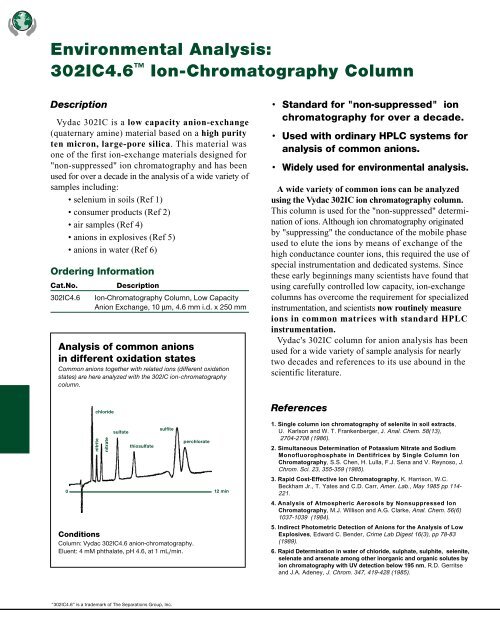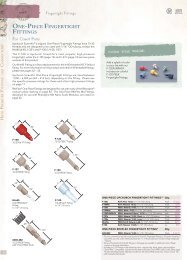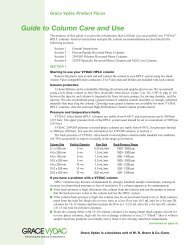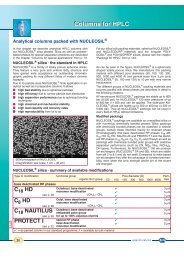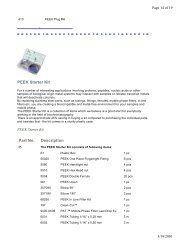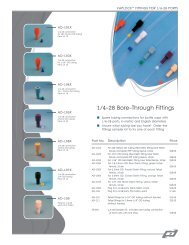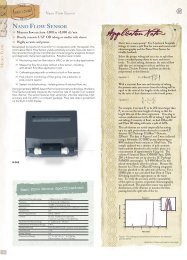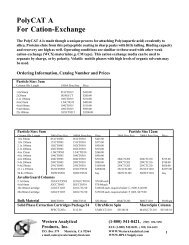302IC4.6⢠Ion-Chromatography Column - Western Analytical
302IC4.6⢠Ion-Chromatography Column - Western Analytical
302IC4.6⢠Ion-Chromatography Column - Western Analytical
You also want an ePaper? Increase the reach of your titles
YUMPU automatically turns print PDFs into web optimized ePapers that Google loves.
Environmental Analysis:302IC4.6 <strong>Ion</strong>-<strong>Chromatography</strong> <strong>Column</strong>DescriptionVydac 302IC is a low capacity anion-exchange(quaternary amine) material based on a high purityten micron, large-pore silica. This material wasone of the first ion-exchange materials designed for"non-suppressed" ion chromatography and has beenused for over a decade in the analysis of a wide variety ofsamples including:• selenium in soils (Ref 1)• consumer products (Ref 2)• air samples (Ref 4)• anions in explosives (Ref 5)• anions in water (Ref 6)Ordering InformationCat.No.302IC4.6Description<strong>Ion</strong>-<strong>Chromatography</strong> <strong>Column</strong>, Low CapacityAnion Exchange, 10 µm, 4.6 mm i.d. x 250 mmAnalysis of common anionsin different oxidation statesCommon anions together with related ions (different oxidationstates) are here analyzed with the 302IC ion-chromatographycolumn.chloride• Standard for "non-suppressed" ionchromatography for over a decade.• Used with ordinary HPLC systems foranalysis of common anions.• Widely used for environmental analysis.A wide variety of common ions can be analyzedusing the Vydac 302IC ion chromatography column.This column is used for the "non-suppressed" determinationof ions. Although ion chromatography originatedby "suppressing" the conductance of the mobile phaseused to elute the ions by means of exchange of thehigh conductance counter ions, this required the use ofspecial instrumentation and dedicated systems. Sincethese early beginnings many scientists have found thatusing carefully controlled low capacity, ion-exchangecolumns has overcome the requirement for specializedinstrumentation, and scientists now routinely measureions in common matrices with standard HPLCinstrumentation.Vydac's 302IC column for anion analysis has beenused for a wide variety of sample analysis for nearlytwo decades and references to its use abound in thescientific literature.References0nitritenitratesulfatethiosulfatesulfiteConditions<strong>Column</strong>: Vydac 302IC4.6 anion-chromatography.Eluent: 4 mM phthalate, pH 4.6, at 1 mL/min.perchlorate12 min1. Single column ion chromatography of selenite in soil extracts,U. Karlson and W. T. Frankenberger, J. Anal. Chem. 58(13),2704-2708 (1986).2. Simultaneous Determination of Potassium Nitrate and SodiumMonofluorophosphate in Dentifrices by Single <strong>Column</strong> <strong>Ion</strong><strong>Chromatography</strong>, S.S. Chen, H. Lulla, F.J. Sena and V. Reynoso, J.Chrom. Sci. 23, 355-359 (1985).3. Rapid Cost-Effective <strong>Ion</strong> <strong>Chromatography</strong>, K. Harrison, W.C.Beckham Jr., T. Yates and C.D. Carr, Amer. Lab., May 1985 pp 114-221.4. Analysis of Atmospheric Aerosols by Nonsuppressed <strong>Ion</strong><strong>Chromatography</strong>, M.J. Willison and A.G. Clarke, Anal. Chem. 56(6)1037-1039 (1984).5. Indirect Photometric Detection of Anions for the Analysis of LowExplosives, Edward C. Bender, Crime Lab Digest 16(3), pp 78-83(1989).6. Rapid Determination in water of chloride, sulphate, sulphite, selenite,selenate and arsenate among other inorganic and organic solutes byion chromatography with UV detection below 195 nm, R.D. Gerritseand J.A. Adeney, J. Chrom. 347, 419-428 (1985).“302IC4.6” is a trademark of The Separations Group, Inc.
Environmental and Food Analysis: 201TP and202TP Specialty Reversed-Phase <strong>Column</strong>sPolyaromatic hydrocarbons (PAHs) are large organicmolecules produced during combustion. Many PAHsare carcinogenic. For this reason the United StatesEnvironmental Protection Agency (EPA) and othergovernmental agencies have formulated regulationsfor the monitoring and control of PAHs and havedeveloped methods for their measurement in air,water, food, and other components of the humanenvironment.The EPA has designated sixteen PAHs as PriorityPollutants (see Figure on page 54). EPA Methods 610and 550 deal with the measurement of PAHs indrinking water and Method 8310 deals with themeasurement of PAHs in waste water. These EPAmethods specify reverse phase High PerformanceLiquid <strong>Chromatography</strong> (HPLC) for measurement ofthe PAHs.Vydac 201TP HPLC columns have long been thestandard in the analysis of PAHs by HPLC. Vydac201TP and 202TP HPLC columns have been specificallydeveloped to perform the separation and quantitationof PAHs required by environmental regulations – notonly regulations presently in force but also newregulations on the horizon.Vydac 201TP columns have been used to establishstandard reference materials (Ref. 1, 5*), measure airquality (Ref. 1-4*), measure PAHs in sediments(Ref. 6*), quantitate PAHs in food (Ref. 7-8*), andstudy high molecular weight PAHs (Ref. 9*). Theyhave also been used in the study of shape selectivityof reversed phase materials.* References on page 56.Ordering InformationCat.No.Description201TP54 Specialty Reversed-Phase <strong>Column</strong>, C 18,5 µm, 300 Å, 4.6 mm i.d. x 250 mm201TP5415 Specialty Reversed-Phase <strong>Column</strong>, C 18,5 µm, 300 Å, 4.6 mm i.d. x 150 mm202TP54 High-Carbon-Load Reversed-Phase <strong>Column</strong>,C 18, 5 µm, 300 Å, 4.6 mm i.d. x 250 mm202TP5415 High-Carbon-Load Reversed-Phase <strong>Column</strong>,C 18, 5 µm, 300 Å, 4.6 mm i.d. x 150 mmRapid-Analysis <strong>Column</strong>:202TP3405 High-Carbon-Load Reversed-Phase <strong>Column</strong>,C 18, 3 µm, 300 Å, 4.6 mm i.d. D x 50 mmFeatured products are:❏ 201TP54 and 201TP5415 columns – thestandard for PAH analysis in all types of environmentalsamples. Vydac 201TP columns separatethe EPA sixteen priority pollutants in less thantwenty minutes (see top figure on page 54).❏ 202TP3405 Rapid-Analysis columns newlydeveloped to separate the 16 Priority PollutantPAHs in under 10 minutes (see bottom figure onpage 54).❏ 202TP54 and 202TP5415 columns for theanalysis of derivatized PAHs.Beyond the 16 EPA priority pollutant PAHs, VydacPAH columns are used to separate many other PAHs,such as methylated naphthalenes (see figure on page 55and Ref. 9 on page 56).Vydac 201TP HPLC columns have longbeen the standard for the analysis ofPAHs in:• Water• Air• Soil• Automotive Exhaust• Food“201TP” and “202TP” are trademarks of The Separations Group, Inc.
Environmental and Food Analysis: 201TP and 202TP Specialty Reversed-Phase <strong>Column</strong>sAnalysis of Priority-PollutantPolyaromatic Hydrocarbons inaccordance with EPA Methods 550,550.1, 610, and 8310.Priority Pollutant PAHs1. naphthalene2. acenaphthylene3. acenaphthene4. fluorene5. phenanthrene6. anthracene7. fluoranthene8. pyrene9. benz(a)anthracene10. chrysene11. benzo(b)fluoranthene12. benzo(k)fluoranthene13. benz(a)pyrene14. dibenz(a,h)anthracene115. benzo(g,h,i)perylene16. indeno(1,2,3,c,d)pyrene245679101112131516<strong>Column</strong>: Vydac 201TP5415 (C 18 , 5 µm, 4.6 mm i.d. x 150 mm).Eluent: 3 min. hold at 50% ACN; then gradient from 50 to 100%ACN in 7 min. at 1.5 mL/min. Detection: UV at 254 nm.Sample: Priority Pollutant PAH mixture.0381415 minRapid Analysis of PolyaromaticHydrocarbons: Vydac 202TP3405Vydac's 202TP3405 Rapid Analysis PAH column was developed toincrease PAH analytical sample throughput. This column separatesthe 16 EPA PAHs in about ten minutes including column equilibrationtime (figure at right), permitting the analysis of up to six samples perhour. With previously available PAH columns, analysis time was often20-30 minutes, allowing analysis of only 2-3 samples per hour. A tencentimeter Rapid Analysis column—the 202TP3410—is alsoavailable with slightly longer retention times and slightly betterresolution. Sample pretreatment (with SPE or similar procedures) toremove insoluble or strongly retained sample components isrecommended to extend the lifetime of three micron columns. It isalso interesting to note that benzo(g,h,i)perylene (14) anddibenz(a,h)anthracene (15) elute in the opposite order from the201TP5415 column (above).1234567891011Priority Pollutant PAHs:1. naphthalene2. acenaphthylene3. acenaphthene4. fluorene5. phenanthrene6. anthracene7. fluoranthene8. pyrene9. benz(a)anthracene10. chrysene11. benzo(b)fluoranthene12. benzo(k)fluoranthene13. benz(a)pyrene14. benzo(g,h,i)perylene15. dibenz(a,h)anthracene16. indeno(1,2,3,c,d)pyrene1213 14 1615<strong>Column</strong>: Vydac 202TP3405 Rapid PAH Analysis, (C 18 , 3 µm, 4.6 mm i.d.x 50 mm). Eluent: 40-95% acetonitrile in water in 8 min. Flow rate: 3mL/min. Temperature: 30°C.0 8 min
Environmental and Food Analysis: 201TP and 202TP Specialty Reversed-Phase <strong>Column</strong>sBeyond the EPA 16Priority-Pollutant PAHsBeyond the EPA 16 priority-pollutant PAHs are many carcinogenicPAHs that may be found in the environment. Regulatory agenciesare considering the addition of several of these compounds to thelist of regulated polyaromatic hydrocarbons. Vydac 201TP5415columns, widely used for PAH analysis, are able to separate manyPAHs beyond the original sixteen using a modified gradient (figureat right). Additional PAHs separated here include: 1-methylnaphthalene,2-methylnaphthalene, benzo(c)phenanthrene, cyclopenta(c,d)pyrene,benzo(b)naptho(2,1-d)thiopen, 7,12 dimethylbenz(a)anthracene andbenzo(e)pyrene. Many other high molecular weight PAHs have beenseparated on Vydac 201TP columns (see Ref. 9 on page 56).Conditions<strong>Column</strong>: Vydac 201TP5415 (C 18 , 5 µm, 4.6 mm i.d. x 150 mm).Eluent: 50-100% ACN in water over 30 min. Flow rate:1 mL/min. Temperature: 30°C.127643589101114181613 1512 171920Polyaromatic Hydrocarbons1. naphthalene2. acenaphthylene3. 1-methylnaphthalene4. 2-methylnaphthalene5. acenaphthene6. fluorene7. phenanthrene8. anthracene9. fluoranthene10. pyrene11. benzo(c)phenanthrene12. cyclopenta(c,d)pyrene13. benz(a)anthracene14. chrysene15. benzo(b)naptho(2,1-d)thiopen16. 7,12-dimethylbenz(a)anthracene17. bezo(e)pyrene18. benzo(b)fluoranthene19. benzo(k)fluoranthene20. benz(a)pyrene21. dibenz(a,h)anthracene22. benzo(g,h,i)perylene23. indeno(1,2,3,c,d)pyrene212223032 minBuckminsterfullerenesBuckminsterfullerenes, also known as "buckyballs", are large, symmetricalmolecules of carbon resembling soccer balls and are extremely hydrophobic.Existing in sizes from 60 carbon atoms and up, these very hydrophobicmolecules are difficult to separate by conventional means. Reversed-phaseHPLC with Vydac 201TP columns and non-aqueous solvents have done thetrick.C 70C 60C 76 C 84Conditions<strong>Column</strong>: Vydac 201TP510 (C 18 , 5 µm, 10 mm i.d. x 250 mm).Eluent: 1:1 acetonitrile:toluene at 5 mL/min.Data from Acc. Chem. Res. 25, 119-126 (1992).020 min
Environmental and Food Analysis: 201TP and 202TP Specialty Reversed-Phase <strong>Column</strong>sβ–Carotenesβ–Carotenes are large, naturally occurring molecules found in manyfood sources, particularly some fruits and vegetables, which appearto prohibitively affect cancer in humans. Reversed-phase HPLC is aneffective tool for the study of β–carotenes as illustrated here with theanalysis of an extract of canned carrots.α - caroteneβ- caroteneConditions<strong>Column</strong>: Vydac 201TP54 (C 18 , 5 µm, 4.6 mm i.d. x 250 mm).Eluent: 94:6 methanol:chloroform.Data from J. Liq. Chrom. 10(4), 643-653 (1987).cis-α - carotene13-cis-β - carotene9-cis-β - carotene0 10 20 minReferencesPolyaromatic HydrocarbonsAir particulates: Vydac 201TP columns are used to measure PAHs inair resulting from fuel combustion and cigarette smoke and were usedin establishing two NIST air particulate SRMs.1. Characterization of the Polycyclic Aromatic Hydrocarbons fromTwo Standard Reference Material Air Particulate Samples, S.A.Wise, B.A. Benner, S.N. Chesler, L.R. Hilpert, C.R. Vogt, and W.E.May, Anal. Chem. 58(14), 3067-3077 (1986).2. Liquid Chromatographic Determination of Polycyclic AromaticHydrocarbons in Air Particulate Extracts, W.E. May and S.A. Wise,Anal. Chem. 56 (2), 225-232 (1984).3. Summertime Variations in Polycyclic Aromatic Hydrocarbons AtFour Sites in New Jersey, R. Harkov, A. Greenberg, F. Darack, andJ.M. Daisey, Env. Sci. &Tech. 18(4), 287-291 (1984).4. The Quantification of 4-6 Ring Polynuclear Aromatic Hydrocarbonsin Indoor Air Samples by High-Performance Liquid <strong>Chromatography</strong>,C. H. Risner and J. M. Conner, J. Liq. Chrom. 14(3), 437-463(1991).Coal Tar: Vydac 201TP columns were used to establish the U.S. NISTcoal tar SRM.5. Determination of Polycyclic Aromatic Hydrocarbons in a Coal TarStandard Reference Material, S.A. Wise, B.A. Benner, G.D. Byrd,S.N. Chesler, R.E. Rebbert, and M.M. Schantz, Anal. Chem. 60(9),887-894 (1988).6. Quantitative Analysis of Polycyclic Aromatic Hydrocarbons inRecent Sediments by Liquid <strong>Chromatography</strong> with FluorometricDetection, H.H. Soclo, P. Garrigues, and M. Ewald, Analusis 14(7),344-350 (1986)Foods: Vydac 201TP columns have been used to measure PAHs incoffee and other foods.7. Rapid Determination of Benzo(a)pyrene in Roasted Coffee andCoffee Brew by HPLC with Fluorescence Detection, N. de Kruijf, T.Shouten and G.H.D. van der Stegen, J. Ag. Food Chem. 35, 545-549(1987).8. Determination of Nanogram/kilogram Levels of PolycyclicAromatic Hydrocarbons in Foods with Fluorescence Detection.,J.F. Lawrence and B.S. Das, Int. J. Envir. Anal. Chem. 24(2), 113-131(1986).Large PAHs: A Vydac 201TP column was used to measure highmolecular weight PAHs in carbon black.9. High Performance Liquid Chromatographic Separation of HighMolecular Weight Polycyclic Aromatic Compounds in CarbonBlack, P.A. Peaden, M.L. Lee, Y. Hirata, and M. Novotny, Anal.Chem. 52(14), 2268-2271 (1980).Carotenoids10. Changes of Carotenoids, Color, and Vitamin A Contents duringProcessing of Carrot Juice, B.H. Chen, H.Y. Peng, and H.E. Chen,J. Agric. and Food Chem., 43, 1912-1918 (1995).11. Simultaneous Profiling and Identification of Carotenoids,Retinols, and Tocopherols by High Performance Liquid <strong>Chromatography</strong>Equipped with Three-Dimensional Photodiode ArrayDetection, A. Ben-Amotz, J. Liquid Chromatog.,18(14), 2813-2825(1995).12. Reverse Phase HPLC Separation of cis- and trans-carotenoidsand its Application to β-Carotenes in Food Materials, F.W.Quackenbush, J. Liq. Chrom., 10, 643-653 (1987).


